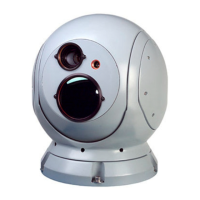
Do you have a question about the FLIR SeaFLIR II Series and is the answer not in the manual?
| Brand | FLIR |
|---|---|
| Model | SeaFLIR II Series |
| Category | All in One Printer |
| Language | English |
Defines the manual's purpose, scope, and system configurations for the SeaFLIR II Imaging System.
Describes the SeaFLIR II Imaging System's capabilities, applications, and operational platforms.
Details the key features and technical specifications of the SeaFLIR II Imaging System.
Describes the primary units of the SeaFLIR II Imaging System: SGA, CEU, and HCU.
Explains the system's power requirements, input voltage, and maximum current.
Illustrates the typical system interconnect diagram for the SeaFLIR II Imaging System components.
Details the functions and uses of the SeaFLIR II Imaging System's controls and indicators on the Hand Control Unit (HCU).
Explains the system's pull-down menus for operator customization and accessing optional features.
Provides a step-by-step guide for powering on and initializing the SeaFLIR II Imaging System.
Outlines the procedure to reset the SeaFLIR II Imaging System computers in case of unresponsiveness.
Describes the correct steps for safely powering down and securing the SeaFLIR II Imaging System.
Guides the operator through initial setup tasks like entering agency name and date/time.
Introduces the Auto-Tracker feature, its importance, and modes for automated target tracking.
Explains how to select and use the Auto-Tracker modes, adjust window size, and re-acquire targets.
Details how to use radar bearing data for visual identification of radar-tracked targets.
Outlines a procedure for performing an operational checkout test of the SeaFLIR II Imaging System.
Describes the Auto-Scan feature for searching areas and setting scan parameters.
Explains the information presented on the display monitor to aid operator understanding.
Guides the user on how to operate the Infrared (IR) camera, including selection and focus.
Guides the user on how to operate the CCD camera, including selection and focus.
Explains how to use the Strain Gauge for controlling the SGA's Azimuth and Elevation movement.
Emphasizes the importance of performing preventive maintenance for optimal system operation.
Covers essential preventive maintenance tasks, including cleaning and system wash-down.
Advises on proper procedures for packaging and shipping the SGA for repair or storage.
Explains infrared light, its spectrum, waveband, and how the SeaFLIR II camera detects it.
Discusses factors influencing infrared light intensity, such as object temperature and surface properties.
Addresses the camera's ability to detect internal wall materials based on thermal conductivity differences.
